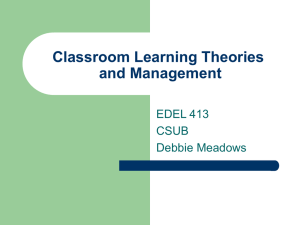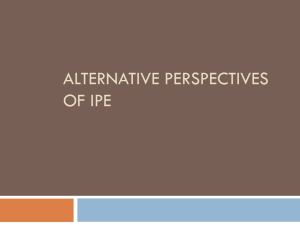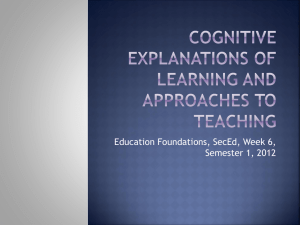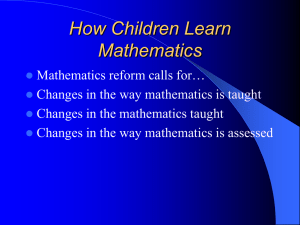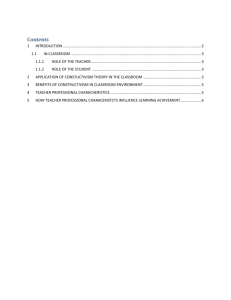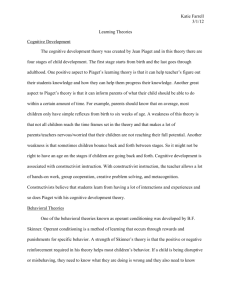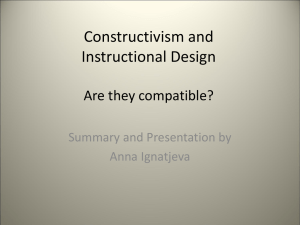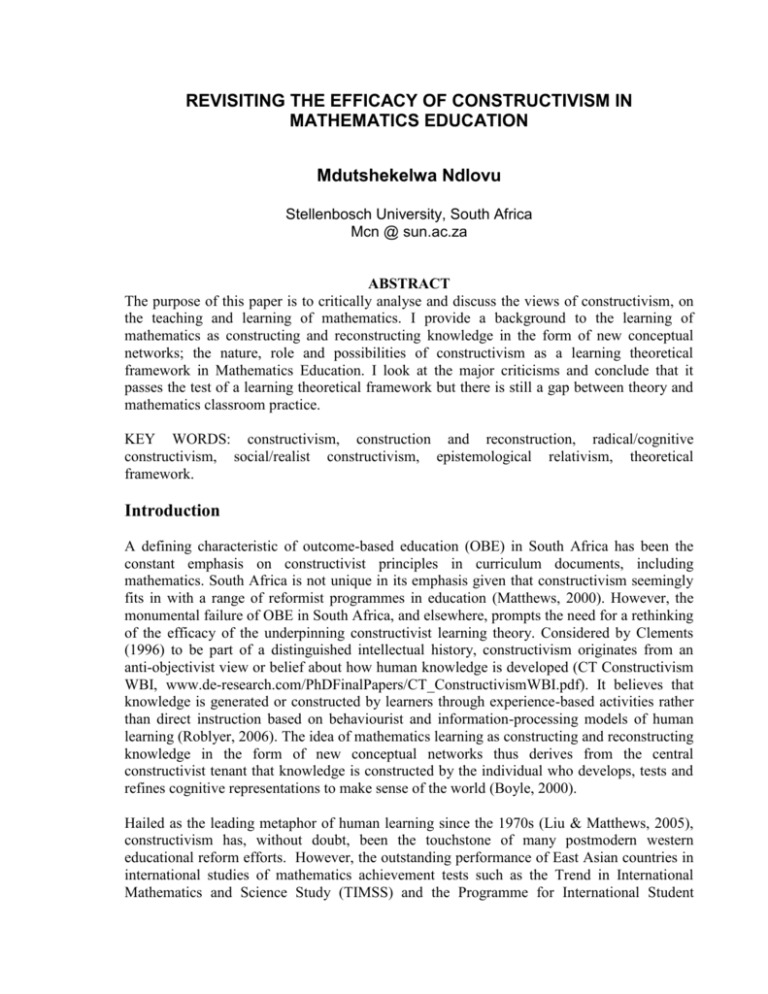
REVISITING THE EFFICACY OF CONSTRUCTIVISM IN
MATHEMATICS EDUCATION
Mdutshekelwa Ndlovu
Stellenbosch University, South Africa
Mcn @ sun.ac.za
ABSTRACT
The purpose of this paper is to critically analyse and discuss the views of constructivism, on
the teaching and learning of mathematics. I provide a background to the learning of
mathematics as constructing and reconstructing knowledge in the form of new conceptual
networks; the nature, role and possibilities of constructivism as a learning theoretical
framework in Mathematics Education. I look at the major criticisms and conclude that it
passes the test of a learning theoretical framework but there is still a gap between theory and
mathematics classroom practice.
KEY WORDS: constructivism, construction and reconstruction, radical/cognitive
constructivism, social/realist constructivism, epistemological relativism, theoretical
framework.
Introduction
A defining characteristic of outcome-based education (OBE) in South Africa has been the
constant emphasis on constructivist principles in curriculum documents, including
mathematics. South Africa is not unique in its emphasis given that constructivism seemingly
fits in with a range of reformist programmes in education (Matthews, 2000). However, the
monumental failure of OBE in South Africa, and elsewhere, prompts the need for a rethinking
of the efficacy of the underpinning constructivist learning theory. Considered by Clements
(1996) to be part of a distinguished intellectual history, constructivism originates from an
anti-objectivist view or belief about how human knowledge is developed (CT Constructivism
WBI, www.de-research.com/PhDFinalPapers/CT_ConstructivismWBI.pdf). It believes that
knowledge is generated or constructed by learners through experience-based activities rather
than direct instruction based on behaviourist and information-processing models of human
learning (Roblyer, 2006). The idea of mathematics learning as constructing and reconstructing
knowledge in the form of new conceptual networks thus derives from the central
constructivist tenant that knowledge is constructed by the individual who develops, tests and
refines cognitive representations to make sense of the world (Boyle, 2000).
Hailed as the leading metaphor of human learning since the 1970s (Liu & Matthews, 2005),
constructivism has, without doubt, been the touchstone of many postmodern western
educational reform efforts. However, the outstanding performance of East Asian countries in
international studies of mathematics achievement tests such as the Trend in International
Mathematics and Science Study (TIMSS) and the Programme for International Student
Assessment (PISA) (ICMI, 2012) when they profess i that their education systems are heavily
steeped in traditional approaches to the teaching of mathematics adds further motivation to reexamine constructivism as a philosophy of learning. In the re-examination process the
questions I attempt to answer in this paper are: What are/were the central tenets of a
constructivist approach to the learning of mathematics? What, in particular, are the
constructivist views on the sources of mathematical knowledge and how does mathematical
knowledge develop in learners? How does constructivism measure up as a theoretical
framework for mathematics learning? What are the challenges to implementing
constructivism in mathematics classrooms?
Learning as the construction and reconstruction of knowledge
The Philosophical Roots of Constructivism
Ernest (1985:607) asserts that constructivism as a philosophy of mathematics dates back to
Kant and Kronecker and comes today via intuitionists like Brouwer (1913), Heyting (1956)
and Bishop (a more recent protagonist). As a philosophy of mathematics constructivism holds
the view that the meaning of mathematical objects consists of the processes by which they are
constructed. It therefore rejects the law of the excluded middle and non-constructive proof by
contradiction. But this perception about constructivism explains only part of its origin as a
philosophy of learning in mathematics education. The other part has its roots in fallibilism
where Lakatos, himself a student of Popper, features prominently. Lakatos turned vehemently
against ‘a dogmatic mathematics of eternal and unimpeachable truth, where quest, failure and
adventure are suffocated’ (Treffers, 1987:241). Presenting mathematics as a subject of
certainty and absolute truth when it’s very foundations were shaky was seen to be unrealistic.
Fallibilism prefers to view mathematics as a dialogue between people tackling mathematical
problems and thus, as a human activity, cannot be isolated from its history, sociology and
applications. Fallibilists believe therefore that mathematicians, being human, are ‘fallible and
their products can never be considered final or perfect but may require re-negotiation’ (Ernest,
1985, p. 608). Consequently heuristically organized instruction need not necessarily follow
the precise course of the historical emergence of the concepts under consideration, just in case
those steps were, after all, less efficient and require re-sequencing (e.g. as happens in calculus
where differentiation is often taught before integration). Rather, argued Lakatos, organized
instruction should come about through ‘a rational reconstruction of the coming into being and
then keeping the learners is mind’ (Treffers, 1987:241). This would leave space for more
efficient and more insightful methods to be invented or created.
The epistemological roots of constructivism
To view learning as construction and reconstruction of knowledge is to wear epistemological
lenses, because epistemology, by definition, is ‘that branch of philosophy specifically
concerned with the origins, validity and development of scientific knowledge’ (Sierpinska &
Lerman, 1996:828) (emphasis added). However, for our purposes as mathematics educators,
Sierpinska and Lerman are of the view that we are less interested in grounds for validity of
mathematics than in explaining the processes of growth of mathematical knowledge. The
consideration here seems to naturally centre on the fact that learning itself fundamentally has
2
to do with the growth and development of knowledge in an individual. To mathematics
educators, therefore, the mechanisms of growth and development, conditions and contexts of
past discoveries and inventions are an area of particular interest. The assumption can be made
that if we can explain the processes of mathematical discovery and invention as they occur or
unfold both in expert mathematicians and in learners, then we are better positioned to deduce
and possibly even re-enact the processes and contexts to help new or younger learners
develop and create their own mathematical knowledge and understandings. Such a prospect
could have influenced Freudenthal (1983) to argue vehemently that learners should be
entitled to recapitulate in a fashion that is the learning process of mankind.
In similar vein, the epistemology of the context of justification argues that the central concern
of mathematics educators should be ‘a rational reconstruction of scientific thought processes
of scientists not just when they are discovering something but also when they are trying to
communicate and justify their findings’ (Sierpinska & Lerman, 1996:830). Accordingly both
the contexts of discovery and of justification can, respectively, help us to understand how
mathematical knowledge is constructed and consequently how it can be reconstructed,
recreated or reinvented. Regarding the context of discovery, Piaget is acknowledged by
Sierpinska and Lerman (1996) to have been the first to coordinate the logic of scientific
discovery with psychological data in a systematic and methodologically clear way. For Piaget,
the objects of epistemology are mechanisms involved in the processes of constitution
(construction and reconstruction) of knowledge in mathematics. In this respect Piaget and
Garcia (1989:3) claim that knowledge is not independent from the process of its formation or
discovery because even the most advanced constructions conserve partial links with their
most primitive forms. Piaget thus stresses the common features of the psychogenesis (or
mental origin) and the historical genesis (or historicity) of mathematical knowledge.
It is clear therefore that within the foundations of mathematics ‘constructivism’ means
something completely different from ‘constructivism’ as a theory of knowledge and
knowledge acquisition. In the first logicist case constructivism refers to constructive proofs as
opposed to non-constructive proofs with the excluded middle such as proof by contradiction.
The second constructivism, which is of particular interest in this paper, comes from general
philosophy and can be described as an epistemology of how knowledge is gained. In the
latter sense, Ernst von Glasersfeld’s basic principles of radical constructivism are that (1)
knowledge is not passively received either through the senses or by way of communication,
but is actively built up (or constructed and reconstructed) by the cognizing agent and (2) the
function of cognition is adaptive and serves the subject’s organization of the experiential
world, not the discovery of an objective ontological reality (Von Glasersfeld, 1988). The first
principle contrasts with and objects to the classic Plutonian view of learners as empty vessels
to be filled with the immutable wisdom, knowledge and skills of the mathematics teacher or
the textbook. The second principle, likewise, acknowledges the role of the knower as an
adapting, cognising agent, arranging new information or knowledge in relation to what is
previously known or has been experienced prior.
Unsurprisingly, Von Glasersfeld (1993) acknowledges that his principles are built on the ideas
of Piaget, who applied the biological concept of adaptation to epistemology. In Glasersfeld’s
cognitive adaption processes there are obvious resonances with Piaget’s equilibration
3
processes of accommodation and assimilation in the formation of new schema or knowledge
networks by the knower. He refers to his ideas as “postepistemological” because his radical
constructivism posits a different relationship between knowledge and the external world than
does traditional epistemology (Johnson, 2008:1)
Basic tenets of constructivism
Students construct their own knowledge
Drawing heavily from Piaget’s work, constructivism ‘focuses on the internal, cognitive or
conceptual development of the learner’s mind or discipline (mathematics) as a whole
(Sierpinska & Lerman, 1996). Clearly, the focal point of mathematical learning is the
(subjective) interior of the child’s mind rather than the subject matter itself as having an
absolute existence outside of the mind. In support of this point of departure for
constructivism, Biggs (1993:73) points out that constructivism emphasizes that ‘people
construct knowledge for themselves… resulting in their own understanding, to their own
looking at things’. This buttresses the view that the active construction and reconstruction of
knowledge is a prerogative of the learner.
Independence and uniqueness of constructions
The knowledge construction or reconstruction process is independent of the way students are
taught. At first glance this seems controversial if not contradictory in the sense that any
method can be justified as leading to some construction and reconstruction. However, in
corroboration of such a tenuous view, Murray, Olivier and Human (1993:73) refer to research
indicating that students construct their own mathematical knowledge irrespective of how they
are taught. That is, no matter how they are taught or communicated with, students will always
form their own understandings and do so even idiosyncratically. This partly explains why two
learners in the same classroom under the same instructor at the same time do not necessarily
attain the same quality of understandings because they bring to the learning context different
prior understandings upon which to construct their new mathematical knowledge. In other
words, the traditional paradigms of viewing teaching as transmission and learning as
absorption of knowledge are put to the lie for if there was a direct mapping from teacher to
the learner then learners would each receive and develop a carbon copy of the imparted
knowledge, skills and repertoires. That is, there would be no individual differences in the
learning outcomes from learner to learner, but we know that this is never the case.
Tynjada (1999) characterises knowledge transmitting paradigms to be no different from
information processing models that are equally unfashionable in a constructivist framework.
Neither are behaviourist stimulus-response models of learning which, like the information
processing models of the 1960s and 1970s, mechanistically treat students as black boxes that
neurologically respond uniformly to likeminded reflex inducing stimuli, rather than as active
learning agents. Or, as Vygotsky noted, the behaviourist models are ‘too narrow, specialised,
isolated and intrapersonal in standpoint’ (Liu & Matthews, 2005). If anything constructivism
presents itself essentially as an antithesis of behaviourism. This implies that educators need to
4
do more listening to students to figure out their thinking processes and for much
understanding to be accomplished. Stanic (1990:239) points out that the instructional
challenge in a constructivist sense should be to lead learners to construct or reconstruct their
own ‘correct’ knowledge – knowledge that corresponds or matches that located in the mindindependent reality.
Recognition of prior understandings
Constructivists, of whatever ilk, consensually recognize that students do not bring into the
classroom empty minds capable of acquiring knowledge mechanically. They bring with them
prior knowledge and predispositions, unique to the individual learner or cognizing agent with
which to ‘actively construct knowledge within the constraints and offerings of the learning
environment’ (Liu & Matthews, 2005) . In this regard Biggs (1996:348) correctly stresses that
the learner brings into the classroom or learning situation ‘an accumulation of assumptions,
motives, intentions, and previous knowledge that envelopes every teaching and learning that
may take place’. In other words, the prior understandings and predispositions invariably
become the prism by which new knowledge is viewed, interpreted and assimilated. This
implies a process of transformation of knowledge which as we have already seen in Tynjada’s
(1999) consideration places constructivism within a knowledge-transforming paradigm.
Eventually, then, what the knower knows are his own quality of constructions and
reconstructions - partly shared/objective and partly subjective only to the extent that prior
understandings coincide with or diverge/differ from those of other learners.
The process of knowledge transformation
In encouraging learners to construct their own knowledge in realistic situations instead of
decontextualized formal situations, constructivists turn to Piaget’s adaptive processes of
assimilation (integration of new objects or situations and events into previous schemes) and
accommodation (changing or expanding internal schemes to reflect and reconcile with new
experiences) to explain the mechanisms by which knowledge is transformed (constructed or
reconstructed) to form new conceptual networks (mental structures, schemata, or constructs)
and thus restore equilibrium in the learner’s understandings. That these processes take place
in the learner suits the constructivist well to see no direct connections between teaching and
learning. In their polemics radical constructivists contend that ‘the teacher’s knowledge
cannot be conveyed to the students, the teacher’s mind is inaccessible to the students, nor are
students’ minds accessible to the teacher’ (Sierpinska & Lerman, 1996:843). Some degree of
pessimistic trepidation with and protestation against the traditional, authoritarian models of
transmission is evident in this formulation. In the constructivist sense therefore educators are
not viewed as teaching students about mathematics but rather as ‘teaching them how to
develop their cognition’ (Confrey, 1990:110).
In other words, teaching must lead the individual learner to make the necessary
accommodations and assimilations to restore equilibrium and lead to more sophisticated
understandings or knowledge networks. To do so effectively, the constructivist argues that the
teacher’s task must centre on inferring models of the students’ conceptual constructs (or
networks) and subsequently generating hypotheses as to how students can be given the
5
opportunity to modify (reconstruct) their conceptual structures or schemas. Learning is
therefore distilled into a human activity driven and propelled by self-reliant, self-reflexive
cognitive actions of equilibration and re-equilibration which cause movement from one level
of understanding to a new level of sense making.
The social dimension of construction and reconstruction
Constructivism is not only concerned with meaning construction as an individual activity but
also as a social activity. Kanselaar (2002) refers to these two perspectives as cognitive
constructivism, an individualistic perspective with its roots in Piaget’s work already
described, and socio-cultural constructivism, a socio constructivist perspective with its roots
in Vygotsky’s work. In the latter perspective, interaction is viewed as the primary raw
material for the cognitive constructions that people build to make sense of the world (Boyle,
2000). In fact, for Gavosto, Krantz and McCallum (1999:128), among the false charges laid
against constructivism are that students must ‘invent all of school mathematics… and (do so)
…. solely by working in small groups’. Rather, as Ernest (1991:42) puts it, in a socioconstructivist classroom, the construction or reconstruction of knowledge is ‘firstly an
individual and secondly a social activity’. Ernest further stresses that the basis of
mathematical knowledge is linguistic knowledge, conventions, and rules, and language itself much as conventions and rules are - is a social construction. In agreement with Ernest social
dimension of construction, Ball (1993:376) makes the remark that ‘because mathematical
knowledge is socially constructed and validated, sense making is both individual and
consensual’.
Furthermore, interpersonal social processes must come into play in order to turn an
individual’s subjective mathematical knowledge into accepted objective mathematical
knowledge. In other words, for learning to be deemed to have occurred and for constructions
and reconstructions of knowledge to be deemed to have led to new conceptual networks in a
group context, personal constructions of knowledge must be communicated, justified and
accepted by the group. Once accepted by the group, the new conceptual structures assume a
truth value or objectivity-status of taken-to-be-shared knowledge. The process of sharing
implies explaining and justifying one’s mathematical understanding or problem solving
procedure to others. In turn, other members of the group have an obligation to subject the
explanation to scrutiny, critical reflection, before reaching consensus. This implies group
construction, and reconstruction which inherently embodies group reflective thinking. In other
words, the attainment of a new level of conceptualization is a product of collaborative
constitution and reconstitution, co-responsibility and co-ownership. That is, dialogue and the
negotiation of meaning provide the basis for the individuals to develop, test and refine their
ideas (Boyle, 2000).
Put differently, the group undergoes the same Piagetian processes of assimilation and
accommodation to adapt and achieve a new equilibrium. In his later works, Piaget
acknowledged the importance of social interaction between fellow students and valued
equally the individual and the social (Treffers 1987; Cole & Wertsch 2004). In his own way
Piaget conceded that ‘there is no longer any need to choose between the primacy of the social
6
or that of the intellect: collective intellect is the social equilibrium resulting from the interplay
of ... cooperation’ (Piaget, 1970 in Cole & Wertsch, 2004). In a sense, the point is
acknowledged that the diverging opinions of members of the groups can induce the student to
reflect critically on his/her own ways of thinking. Treffers (1987) refers to this interpretation
of group effect on the individual’s learning as Piaget’s version of what is now known as the
socio-cognitive conflict. That is, the group eventually and cumulatively lifts each member
who composes it to new levels of conceptual networks and understanding.
A classroom fostering powerful constructions and reconstructions
Confrey (1990:111) characterizes a constructivist classroom as one which encourages the
construction of powerful and effective constructions in mathematics. In order to construct
powerful mathematical ideas or conceptual networks students must believe in their
knowledge. That belief in what they construct for themselves implies knowledge from a
constructivist point of view. Confidence in one’s abilities staves away fear – fear of success or
fear of failure. In some respects, this brings us full circle round and back to Lakatos and fully
humanizes mathematics education.
Confrey (1990) lists the following conditions to be satisfied for effective or powerful
constructions (or reconstructions) to take place in a constructivist classroom: (I elaborate
briefly on each condition in my own way)
1. A structure with a measure of internal consistency, i.e. in order that no proposition
and its opposite can be proved using the same axioms
2. Integration across a wide variety of concepts, i.e. for accommodative and
assimilative processes to be able to take place elaborately.
3. A convergence among multiple forms and contexts of representations i.e. to
strengthen and raise the level and quality of mathematical understandings and
mathematical ways of thinking.
4. An ability to be reflected on and be described i.e. to improve the quality of
mathematical reasoning.
5. A historic continuity i.e. to build on past knowledge and be available for the
construction of higher conceptual networks in tandem with existing expert
knowledge.
6. Ties into various symbol systems i.e. to obviate reinventing mathematical
symbolism and thus facilitate effective but concise communication within and
between the mathematical communities.
7. An agreement with experts, i.e. to maintain the universality of mathematical
norms, ethics and standards.
8. A potential to act as a tool for further constructions, i.e. to leave room for future
discoveries, constructions and reconstructions as a fact of mathematical life and
knowledge dynamics.
9. A guide for future actions i.e. to obviate the need for future re-invention of the
wheel, but rather point directions for further research and exploration
10. Ability to be justified and defended, i.e. to strengthen the context of justification as
a point of departure for a sound mathematical culture.
7
Some criticisms of constructivism
The plethora of constructivist variants
A first hurdle in appraising constructivism is that, perhaps, owing to its infancy in the
nineties, it has had varieties or what Phillips (1995) refers to as the many faces of
constructivism – the good, the bad and the ugly – with some internal rivalry. Stanic
(1990:288), for instance points to relativism as a potential source of tension between
empiricist-oriented constructivists and radical constructivists. Although both varieties are
unanimous in their claim that mathematical knowledge is constructed actively by learners in
the process of adapting to their environment they however differ in their view of knowledge
and reality. In the same regard Cobb (1986) points out that empiricist constructivists locate
knowledge in an external environment and see it existing independent of the child’s cognitive
activity, yet radicals believe knowledge does not exist independently of the knower. Radicals
also see learning as a problem solving process in which learners attempt to overcome
obstacles and contradictions that arise when they engage in purposeful activity. Clements
(1996) points out that confusion about what constructivism does and does not mean has
engendered some myths that have diluted and polluted it.
Teaching as more than communication
Stanic (1990) is of the view that the role of teaching as communication is left in ambivalence
by constructivism:
“Are learners never wrong because of good reasons, or are they sometimes wrong but
for good reasons?” (p. 288)
In other words, in its avid quest to be leaner-centred, constructivism leaves the question
begging as to the extent to which educators must do more listening to learners before
intervening. I believe that teaching is essentially a social process of intervention. Accordingly
I wish to agree with Stanic (1990:286) when he pleads with constructivists to take interest in
educators and teaching because ‘knowing about how learners learn simply is not enough’. It
does not lead to a one-to-one mapping from learning to teaching. In other words teaching is
more than mere communication. It is expert intervention and negotiation of meaning with
learners and deserves more pedagogical space even after making allowances for the pretext
that constructivism is, after all, an attempt as learning rather than teaching theory. As teachers
we need to understand our students’ thinking at a deeper level than everyday communication
(Clements, 1996). We cannot learn much about learners unless we learn about their learning
and construction of understandings about specific mathematical content.
Lack of clarity about the meaning of construction
In his trademark sarcasm, Freudenthal (1991:143) questions the very meaning of
‘construction’ or ‘reconstruction’ as subsumed by constructivism and charges that these are
8
words that can mean everything and their opposites. This is something akin to anything and
everything. If, for instance ‘constructing’ rings like creating and then ‘reconstruction’ is mere
‘re-creation’ that is no different from reconstructing the means in which something was first
constructed. Freudenthal (1991) thus proposes ‘re-invention’ as a more appropriate term,
which, however, must the distinguished from mere reproduction. The reader can be excused
for perceiving more an exercise in semantics than any substantive difference in essence and
substance. One can safely put ‘invention’, ‘discovery’, ‘construction’, ‘creation’ in the same
basket of synonyms if their basic import in the literature is considered. ‘Re-invention’,
‘reconstruction’ and ‘re-creation’ could similarly be packaged together. Clements and Ellerton
(1996:94) further criticise constructivism for unnecessarily downplaying the role of language
in (knowledge construction and) communication, paying scant attention to the role of motives,
goals, values, and needs, overemphasizing the role of knowing as arising out of the
individual’s own activity (construction) through a process of cognitive conflict (perturbation),
but in the same breath paying scant attention to knowledge, as something deriving from
social, community, linguistic and cultural agreements and shared understandings acquired
largely through a process of osmosis.
Epistemological relativism of constructivism
Liu and Matthews (2005) contend that recent critical responses to constructivist learning
theories have mostly observed that by emphasising individual or social community
construction of learning, the conclusion of individual or community idiosyncrasy is drawn.
Individual constructivism argues that the universe is no longer an objective, mindindependent existence out there, and by that token all individuals cannot be expected to have
uniform cognition of the same phenomena. In turn social constructivism proposes that crosscommunity transfer of learning cannot and should not be counted on as resulting in an
objective, uniform view of the world. For instance, Ernest’s (1991) well elaborated social
constructivism argues that each culture, like each individual, has the right to integrity and as
such there is no basis for asserting that the values of one culture or society are superior to all
others, nor should Western mathematics be assumed to be superior to any other form because
of its greater power over nature. Liu and Matthews (2005) attest that these claims lead to
epistemological relativism, where there exists no absolute truth and any truth is as good as the
other. Some critics consequently blame social constructivism for leading to “group think”
which tends to produce a “tyranny of the majority”, wherein a few students’ voices dominate
the group’s conclusions, and dissenting students are forced to conform to the emerging
consensus (Thirteen.org, n.d.)
The quasi-religious or ideological aspect of constructivism
Liu and Matthews (2005) point out that perhaps, owing to its growing status as a large-scale
movement (Phillips, 1995) constructivism has been criticised for its quasi-religious or
ideological aspect which reduces it to a secular religion. This quasi-religious or ideological
aspect of constructivism is said to be closely linked to the ambition of prescribing it as the
human epistemology. The ambition to prescribe the so-called ‘truth’ about human
epistemology and about the universe as the object of knowing inadvertently elevates
constructivism to an exclusive church of thinking (Liu & Matthews, 2005). Such an elevation
9
has lead to constructivism being viewed as an elitist theory that has been most successful with
children from privileged backgrounds who are fortunate in having outstanding teachers,
committed parents, and rich home environments (Thirteen.org, n.d.). Furthermore, critics say
that in spite of the hype, there is little evidence that constructivist methods work, instead, by
rejecting evaluation through testing and other external criteria, constructivists have made
themselves unaccountable for their students’ progress. Even more damning is that studies of
various kinds of instruction (e.g. Project Follow Through) have found that students in
constructivist classrooms lag behind those in more traditional classrooms in basic skills
(Thirteen.org, n.d.). This brings back to mind the dominance of the East Asian students in
international benchmark tests up to and including the recently published TIMSS 2011 results
(see Mullis, Martin. Foy & Arora, 2012)
Viability of constructivism as a learning theoretical framework
Definition and description of a theoretical framework
I turn to Freudenthal for what I can conceptually understand to be a theoretic framework. He
defines theorizing as organizing fields of experience the result of which is gifted with a
structure that is a product of cogitation, reflection and argumentation (Freudenthal, 1991:129).
He further points out that a theoretical framework can be designed beforehand, or shaped in
an incessant interaction with the matter to be framed. He climaxes his description by stating
that an apriori definition of theoretic framework would be ‘a more or less connected set of
theoretic statements and conceptual tools obtained by theorizing and may be including minitheories, and reflecting the essentials of an actual or imagined instructional system.
Verdict on constructivism
Constructivism as discussed in this paper has tried to organize the field of learning
experiences as individual or interactive constructions and reconstructions of knowledge. It has
traced some ‘deep’ thinking (cogitation), reflection and argumentation about how students
construct and reconstruct meaning by the processes of assimilation, accommodation,
individual and collective reflection. That is to say, it has been portrayed as a more or less
connected set of theoretic statements about the essential means by which mathematics
learning can be described as a culmination of qualitative constructions and reconstructions
based on prior understandings and resulting in new conceptual networks. Going by the criteria
constructivism perhaps remains a good idea, insufficiently understood and badly
implemented.
Summary and conclusion
In this paper I have attempted to give a background to the evolution of constructivism as a
philosophy and as a learning theory. I have enumerated its basic tenets, critiqued it as a theory
and evaluated it as a theoretical framework in mathematics education. Teachers of
mathematics (and science) should be aware that:
constructivism is one worldview among many competing for the same pedagogical
space e.g. constructivism not the only theory emphasizing active learning,
10
behaviourist virtue of practice and yet more practice still holds sway in many
classrooms;
direct teaching can be more time efficient, and can also produce excellent test results
as evidenced by TIMSS and PISA results;
constructivism is still a developing theory that needs more research support;
constructivism emphasizes that learners construct their own meanings individually or
collectively irrespective of accuracy;
the teacher’s role is to create optimal conditions for successful constructivist learning
to take place e.g. learners should have the prior knowledge necessary to scaffold them
beyond their zone of proximal development;
constructivism does not mean learners cannot learn from the teacher’s lecture, only
that telling or lecturing should not be the dominant classroom discourse;
constructivism should not be elevated to a gospel truth where it operates in splendid
isolation;
constructivism has been criticized in the literature for being elitist, and should be
adopted and encouraged with sensitivity to the learning needs of learners from
disadvantaged backgrounds;
constructivism is not a unified theory, it has internal rivalries and contradictions
within its variants;
mathematics learning should involve contexts that learners can identify with to
enhance relational understanding;
constructivism does not imply teaching through small groups alone; and
group work should be used with clear classroom norms and standards to obviate it
from becoming groupthink e.g. respect for each learner’s views together with
appropriate justification, contestation and collective rationality..
I therefore agree with Windschitl (2002) that ‘the dilemma in mathematics classrooms is that
the most profound challenges for teachers are not associated merely with acquiring new skills
but with making personal sense of constructivism as a basis for instruction, reorienting the
cultures of classrooms to be consonant with the constructivist philosophy’ (p. 131). Such a
reorientation effort is made more challenging by the realisation that most teachers often teach
the way they were taught and have little or no experience of reform oriented teaching to draw
inspiration from.
References
Ball DL 1993. With an eye on the mathematical horison: dilemmas of teaching elementary
school mathemtics. The Elementary School Journal , 93 (4), 373-397.
Biggs J 1996. Enhancing teaching through constructive alignment. Higher Education , 32,
347-464.
Biggs J 1993. From theory to practice. Higher Education , 12, 73-85.
Boyle T 2000. Constructivism: A suitable pedagogy for information and computing sciences?
London: LTSN Centre for Information and Computer Science, University of North
London.
Clements AJ & Ellerton NF 1996. Mathematics educaiton Research. Bangkok: UNESCO.
11
Clements DH 1996. Misconstructing constructivism.
Cobb P 1986. Making mathematics: learners' learning and the constructivist tradition.
Harvard Educational Review , 56, 301-306.
Cole M & Wertsch JV 2004. Beyond the Individual-Social Antimony in Discussions of Piaget
and Vygotsky. [Online]. http://www.massey.ac.nz/~alock/virtual/colevyg.htm (24 July
2012) .
Confrey J 1990. What constructivism implies for teaching. In R. B. Davis, C. A. Maher, & N.
Noddings, Constructivist views on the teaching and learning of Mathematics (pp. 107122).
Ernest P 1985. The philosophy of mathematics and mathematics education. International
Journal of Mathematics Education, Science and Technology , 4, 107-122.
Ernest P 1991. The Philosophy of Mathematics Education. London: Falmer.
Freudenthal H 1983. Didactical phenomenology of mathemtical structures. Dodrecht: Reidel.
Freudenthal H 1991. Revisiting Matheamtics Education: China lectures. Dodrecht: Kluwer
academic Press.
Gavosto EA, Krantz SG & McCallum W 1999. Contemporary issues in Mathematics.
Cambridge: Cambridge Unviersity Press.
Johnson PA 2008. Constructivism: a short summary. Available at: http://www.ceptpa.iup.edu/con_mateials.htm Accessed on: 04/03/2008.
Kanselaar G 2002. Constructivism and socio-constructivism. Available at:
http://edu.fss.uu.nl/medewerkers/gk/files/Constructivism-gk.pdf Accessed on
24/07/2012.
Liu CH & Matthews R 2005. Vygotsky's philosophy: constructivism and its criticisms
examined. International Education Journal , 6 (3), 386-399.
Matthews MR 2000. Constructivism in science and mathematics education. Available at:
http://wwwcsi.unian.it/educa/inglese/matthews.html Accessed 23/07/2012.
Murray H, Olivier AI & Human PG 1993. Voluntary interaction groups for problem-centred
learning. Proceedings of the Seventeenth International Conference for the Psychology
of Mathemaitcs Education II, (pp. 73-80).
Mullis IVS, Martin MO, Foy P & Arora A 2012. TIMSS 2011 International Results in
Mathematics. Chestnut Hill, MA: International Association for the Evaluation of
Educational Achievement.
Phillips DC 1995. The good, the bad, and the ugly: the many faces of contructivism.
Educational Researcher , 24 (7), 5-12.
Piaget J & Garcia R 1989. Psychogenesis and the History of Science. New York: Colombia
University Press. Roblyer MD 2006. Intergrating educational technology into teaching
(4th ed). Upper Saddle River, NJ: Pearson Prentice Hall.
Sierpinska A & Lerman. (1996). Epistemologies of Mathematics and of Mathematics
Education. In AJ Bishop, K Clements, C Keitel, J Kilpatrick & C Larborde,
International Handbook of Mathematics Education. Dodrecht: Kluwer.
Stanic MA 1990. Reconstgructing constructivism. In LP Steffe & T Wood, Learners'
Mathematics Education: international perspectives. London: Lawrence Erlbaum
Associates.
Thirteen.org. (n.d.). Constructivism as a paradigm for teaching and learning. Available at:
http://www.thirteen.org/edonline/concept2class/constructivism/index_sub5.html
Accessed 23/07/2012.
12
Treffers A 1987. Three Dimensions: a model of goal theory description of mathematics
instruction. Dodrecht: Reidel.
Tynjada P 1999. Towards expert knowledge? A comparison between a constructivist and a
traditional learning environment in the university. International Journal of educational
Research , 31, 357-442.
Von Glasersfeld E 1993. Introduction: aspects of constructivism. In C. C. Fosnot,
Constructivism: theory, perspectives, and practice (pp. 3-7). New York, NY: Educators
College Press, Columbia University.
Von Glasersfeld E 1988. The reluctance to change a way of thinking. The Irish Journal of
Psychology , 9 (1), 83-90.
Windschitl M 2002. Framing constructivism in practice as the negotiation of dilemmas: an
analysis of the conceptual, pedagogical, cultural, and political challenges facing
teachers. Review of Educational Research , 72 (2), 131-175.
i
Math Education in East Asia, Plenary Panel Discussion chaired by Frederick Leung at the ICME-12 conference,
Seoul, South Korea, July 2012
13




